Decisions, decisions. Few people can make a snap decision without weighing up options. This blog describes how the authors looked further into this as part of the Talking Mats process and discovered it is actually a crucial part of thinking and communicating. A good old Scots word, ‘Swither’ sums it up perfectly. Thank you to Joan Murphy, Norman Alm and Sally Boa members of the Talking Mats Research Network for this fascinating blog.

The Talking Mats Research Network currently includes 47 people from 11 different countries and meets regularly on Zoom. One of its subgroups is looking at how Conversation Analysis can help us to understand how and why Talking Mats works.
The project:
Comparison of the interactions of a man with severe expressive aphasia having two conversations on the same topic – one without Talking Mats and one with Talking Mats. The topic in both cases was how he was managing getting around.
What we found:
- Without Talking Mats: there were more vocalisations in the conversation, but they were less intelligible and there was more confusion between the thinker and the listener.
- With Talking Mats: there were more silences but this was an obvious part of the thinker’s response and by examining how he handled and placed the cards we got a clearer sense of his thinking and intellect.
Further analysis:
- We employed Conversation Analysis techniques to look the session where Talking Mats was used.
- A significant feature which emerged was that, with Talking Mats, the thinker often hesitated while thinking where to place the card, moving the card back and forth before finally settling in one position.
- To explain this, we borrowed the Scottish word ‘swither’. The dictionary definition of swither is ‘to be uncertain as to which course of action to choose’.
Our thoughts / conclusions:
Following discussion, we now feel that swithering, when we move our words or thoughts about in our brain to help us make up our mind, is an important positive feature of conversation. However, a person with a communication disability may find it hard to give a nuanced response and/or we often expect people with a communication difficulty to give a clear ‘yes’ or ‘no’ response. It can be seen as a failing if they appear uncertain, whereas swithering should be regarded as a positive and crucial aspect of how we think and communicate.
One of the many reasons why Talking Mats is successful is that it allows people to ‘swither’ by giving them permission to be unsure and gives them access to a more modulated response.
If you are interested in carrying out reseach in Talking Mats or using Talking Mats as part of your research you can read more here or contact us on info@talkingmats.com
This new resource aims to enable children and young people who have speech, language and communication needs (SLCN) and sensory integration difficulties to have a voice in their therapy assessment, planning and intervention. To find out more about the funding and development for this project please read the earlier blog here.
The project is picking up pace and we are now in the pilot/feedback phase. The resource will be launched in April 2023 and as part of this final launch/sustainability phase, there will be an opportunity for practitioners working with children and young people with sensory needs and communication difficulties to access a free bespoke Talking Mats Foundation Training course.
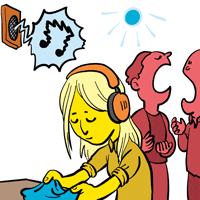
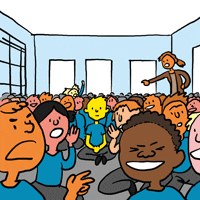

The training:
We are offering non-Talking Mats trained practitioners working in this field the opportunity to apply for a free Talking Mats Foundation live online training course, taking place in May 2023. This training will focus on applying this resource using the Talking Mats key values and process. Training will include a free copy of the resource.
What is involved?
Each course comprises of 2 half day sessions delivered via Teams:
Option 1: Session 1: Wed 10/05/23 9.30 – 12.30
Session 2: Wed 24/05/23 9.30 – 12.30 (including video reflection/feedback)
Option 2: Session 1: Thurs 11/05/23 9.30 – 12.30
Session 2: Thurs 25/05/23 9.30 -12.30 (including video
reflection/feedback)
You will be asked to complete a video of yourself carrying out a Talking Mats session ready to present in Session 2 – this can be up to 5mins long (edited if needed) and ideally involving use of the sensory set, however we are aware that due to consent/privacy issues you may need to do the session with a friend/family member/ colleague and so can provide you with our leisure-home set if required.
After training participants will need to:
- select 3-5 children or young people from your caseloads to use the resource with.
- provide written feedback (a template for this feedback will be provided) by the end of June 2023 at the latest.
The children or young people you select will need to have recognised communication difficulties as well as sensory integration/processing difficulties, and be able to access Talking Mats:
Selection criteria
• Aged between 5-18
• Comprehension skills/understanding at 2 key word level or above
• No/limited visual impairment.
Next steps:
If you are interested in applying for a free training place, please contact Laura Holmes via email at laura@talkingmats.com, by Wednesday 01/03/23. Please include details of your preferred training option/dates (Option 1 or Option 2) and also of your role/ organisation and confirming that you would be able to use the resource post-training, as described above. We will only be accepting one application per organisation.
There are only 24 places available over the 2 training options so please get in touch quickly if you are interested in this opportunity.
Kim Stringer, Director of the Charity Vegetarian for Life, describes her thinking behind this new resource and asks for volunteers to help test it out.
I first had a Talking Mat conversation at the Alzheimer Scotland conference in 2019 and was struck by the way a picture of my likes and dislikes emerged. I wouldn’t have collected all these ideas together in a spoken conversation and I immediately thought this would be a great tool to use to explore an issue that Vegetarian for Life was becoming increasingly aware of.
We support older vegans and vegetarians, and those who care for them, and we had been hearing about some vegetarians with dementia who were asking for meat. It seemed unlikely to us that people who had chosen to be vegan or vegetarian because of their beliefs would suddenly reconsider these views. Staff and families were facing a dilemma and I thought Talking Mats would be a great tool to explore food preferences and perhaps help to find out if a person was genuinely asking for meat.
After initial conversations with Talking Mats we had a seminar to gather other team members’ thoughts, and we began to create the resource. We decided what topics we wanted to cover, how these could be grouped, and what top scales would work.
Dietary Choice

Not all vegetarians like to eat vegetables or meat replacement products and this topic is designed to allow people to express their food preferences. Meat and fish options are included in this topic to help get a reliable picture of a person’s beliefs. When considered along with the conversation arising from the Values topic this gives the opportunity to get a fuller understanding of someone’s motivations. Suggested top scale to use:
Want to eat / sometimes want to eat / don’t want to eat
My eating experience
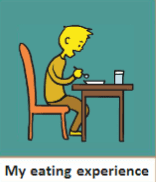
This topic helps explore if someone is happy with their current situation. Some of the symbols cover general subjects, while others are more specifically vegetarian- or vegan-focused. We included things such as celebrations and events. Vegetarians and vegans will want to enjoy these too but may feel excluded if offered something like a salad while others eat burgers. Suggested top scale to use:
Happy / so-so / not happy
Values. Lifestyle
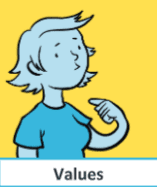
People adopt vegetarian or vegan diets for different reasons and these topics address the reasons behind this choice, and consider the wider lifestyle implications, not just diet. For example someone following a plant-based diet for health reasons may feel differently about toiletries and cleaning products which may have been tested on animals than someone for whom veganism is a philosophical belief. These topics help build a picture of the reasons behind the lifestyle preferences. Suggested top scales to use:
Values: very important / quite important / not important
Lifestyle: want / don’t mind / don’t want
We hope that the conversations generated by the mats will allow care providers to get to better know the person who is receiving care. They may also foster a greater understanding of vegetarianism and veganism.
For more information about good practice when catering for vegetarians and vegans living with dementia, please see Vegetarian for Life’s Memory Care Pledge.
This resource is now in the testing phase and we are looking for volunteers. If you think you can use the resource at least twice between now and the 17th of March please email info@talkingmats.com describing the setting(s) and clients you might use the resource with. We require up to 6 people for this phase.
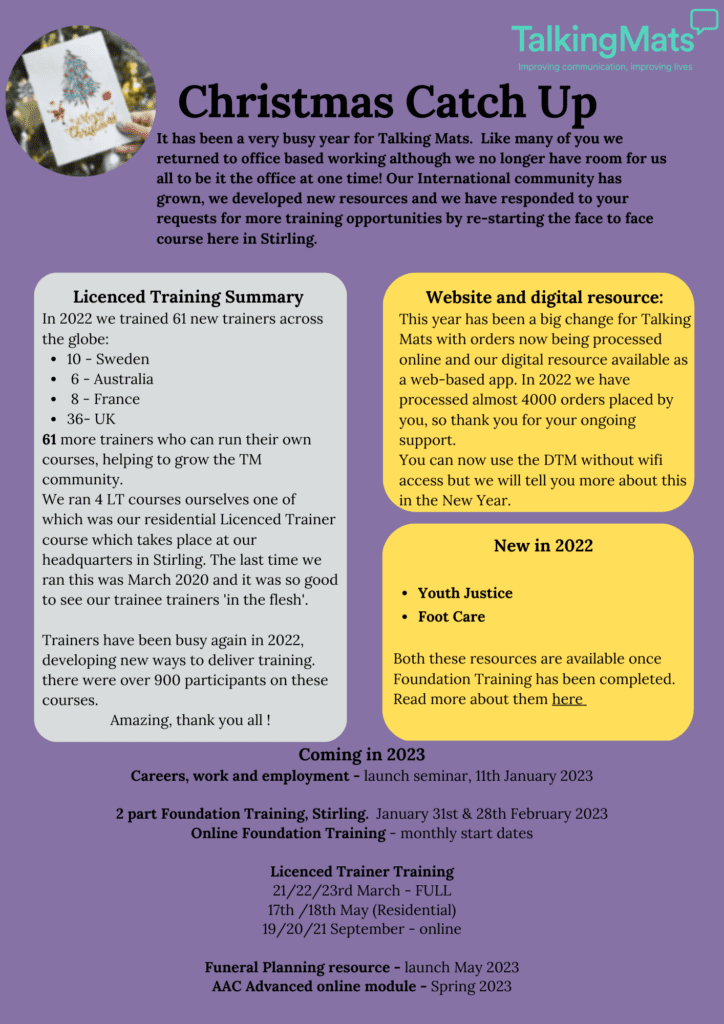
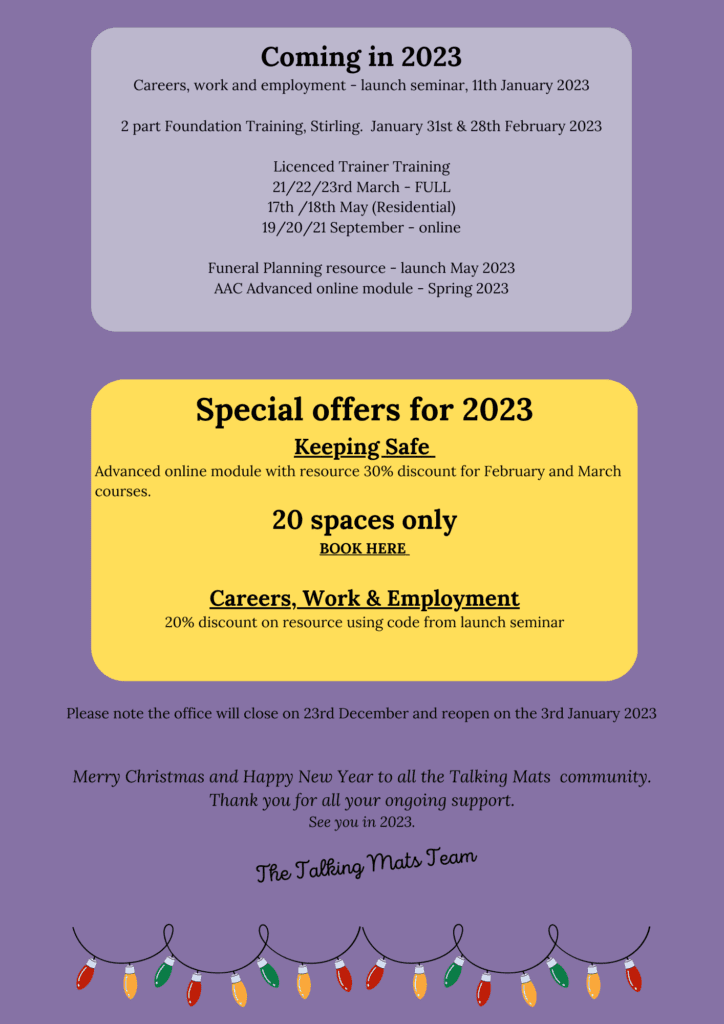
On the 11th of January 2023 the new Talking Mats resource, Careers, Work and Employment will be launched with an online seminar. Alison Cuddington, Speech and Language Therapy Team Leader with Autism East Midland and one of our Licenced Trainers has written about her involvement in developing the resource with staff and students at Sutherland House School.
The context
I work as a Speech and Language Therapy Team Leader at Sutherland House School, a specialist school run by Autism East Midlands. Myself and the team worked on the development of a new resource with Talking Mats looking at providing students at the school the opportunity to communicate their opinions on topics relating to careers.
Careers provision in England is driven by the 8 benchmarks outlined in the 2014 Gatsby ‘Good Career Guidance report’. These are:
- A stable careers programme
- Learning from career and labour market information
- Addressing the needs of each pupil
- Linking curriculum learning to careers
- Encounters with employers and employees
- Experiences of workplaces
- Encounters with further and higher educations
- Personal guidance
Our school was looking to provide careers and education guidance in a way that followed this framework whilst supporting the communication needs of our students. The Careers, Work and Employment resource does this. The complete resource supports careers advisors to work with students in meeting Benchmark 8, ‘Personalise Guidance’, however other benchmarks are more specifically met through the 3 topics:
- Readiness to work
- Skills
- Preferences
Readiness to work

This topic asks the thinker (our students) to consider aspects of health, sensory stimuli, communication, supports etc when thinking about the workplace. Asking students to reflect on these will help them explore appropriate work opportunities, see reasons to engage in activities, and work on areas that are a challenge to their future aspirations. This will enable students to be signposted appropriately and participate in building a careers programme developed around their specific profile (Benchmark 3).
Skills

This topic looks at how a student perceives their own skill set. I found the flexibility of this topic reflected several of the Gatsby benchmarks. For staff, understanding if a student can accurately appraise their own skills will help them amend the careers programme accordingly (Benchmark 3)
My experience has shown that students do not always link their current learning to future employment opportunities. Using this topic allows the introduction of conversations around skills; reflection on strengths and who to approach for help with a skill etc (Benchmark 4)
Thinking about what skillsa student might want to use in a job will help staff attange work encounters/ experiences that are relevant. This can be revisited following a work encounter or experience to help find out if the specific skills were applicable and indeed remain important for an individual after experiencing them in the workplace. (Benchmark 5,6)
This topic also has potential to compare staff / student views on an individual’s areas of strengths and those needing development. Often students do not see the potential that teachers do and this is important feedback.
Work preferences

This topic considers aspects of a job that may or may not be important to an individual; for example being self-employed or working as part of a large company as well as life values. Knowing these preferences allows staff to arrange appropriate work experience placements. Carrying out a mat pre and post work placement will help demonstrate how important these preferences are to a student (Benchmark 6)
For anyone who missed our launch seminar Click Here to find a recording of the session
The Talking Mats funeral resource
Talking about death, loss and funeral planning is something many of us find difficult and challenging. Talking Mats has won funding from the Big Lottery Awards for All to develop a resource that will allow someone to plan their own funeral or be involved in the planning of a loved one’s funeral.
The inspiration
Gillian Robertson who is a celebrant, retired headteacher of a special school and a Talking Mats Licence trainer is the instigator and driver behind this project. She said her inspiration came from being asked to do a funeral of a Dad with two daughters one of whom had additional support needs.
‘When planning his funeral, I spoke mainly to her sister and her mum. They had decided not to tell the other sister the date of the funeral. I had a stomach-churning feeling, this didn’t seem right, but it was not my decision. I had no materials I could offer the family to help make sure their sister was included. It came to the day of the service. To my surprise, the sister was there with her support worker. I was able to have a nice chat with her before the service. When it came to the Committal, she waved goodbye to her dad. I think her mum and sister were a little embarrassed, but I was so glad she was there. She nearly missed the chance to be able to say goodbye or get the closure that other people get from a funeral.’
Development
An effective Talking Mats resource needs a structure that supports the conversation you want to have. Developing this structure benefits from different perspectives. In order to gain these perspectives two different focus groups were set up;
- Celebrants and funeral staff
- People with learning disabilities and their support staff
Discussions led to 3 main topics being identified. Symbols were designed and tested, and the resource further adapted in response to feedback

Final testing phase
The Funeral Resource is now in its final phase of testing where and experienced Talking Mats practitioners are required to use it and feedback results. You will be sent the resource and asked to feedback your experience via Survey Monkey. Funerals are very culturally specific and this set may not work for all cultures and faiths. Knowing the limitations will help the development of guidance to go along with the resource. Testers who can use the resource in diverse settings are particularly welcome.
If you think you could use the resource at least twice between now and the 17th of February 2023 please email lois@talkingmats.com describing the client group you work with, your role and the cultures and faiths you might use the resource with. Up to 8 people will be selected for this next test phase.
In her final blog, April Dobson describes how the training and implementation of Talking Mats across Services led to the decision to use the approach in Hallmark’s annual survey and what was discovered.
For those of us who work in social care settings, there is a requirement to carry out an annual survey each year to determine how people who use the service feel about it. People with communication difficulties often find the various questionnaires lengthy and confusing and it falls to a third party to answer on their behalf.
Following the Talking Mats training and implementation across the service, Hallmark Homes decided to use this approach as part of the 2022 Survey.
How did we do it?
- We selected 12 questions that were concrete in nature and reworded them to follow the Talking Mats principles and guidance.
- Practitioners were given specific symbols, a precise question and a consistent top scale – Happy/Unsure/Not Happy.
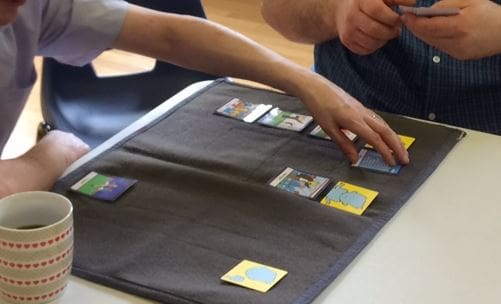
What did we learn?
We ran follow-up focus groups to explore the benefits and challenges.
- Both focus groups reported that using Talking Mats was an inclusive practice.
- Talking Mats discussion often act as a prompt for exploration of specific topics through TM sub-mats to support care and wellbeing (for example weight loss).
- Talking Mats is helpful for people whose first language is not English.
- Talking Mats can help build trust as people feel as though they are being heard and what they say is being acted upon.
- Talking Mats practitioners learned how to tailor the approach to ensure more of our residents can have a say about very local issues.
- Some of the questions need to be reworded.
- Talking Mats should be considered in instances where behaviour may actually be an expression of unmet needs.
- Using Talking Mats did not work for everyone. Selection of residents is key, and in the pre-work leading up to the annual survey next year consideration should be given to reminding practitioners of the circles model, and guidance/learning from this year. This may take the form of pre-survey group meetings on teams.
Although residents who gave their feedback via Talking Mats had a lower rate of positive responses when compared to those who used the traditional method, this is valuable information for Hallmark. The feedback about using Talking Mats in this way was positive;
I really believe this gives a way to hear everybody’s voice you know ……We all sit here with our preconceptions but actually this isn’t about us. This is about us hearing the voice of our residents that wouldn’t have been heard if we hadn’t of used TM as part of the survey.
(Hallmark Regional dementia practitioner)
there are always elements we want to do better and we want to improve. And this is the first iteration (of using TM for the annual survey), of course. But for the first time, I thought, I can say here hand and heart that we’re getting the true representation or a wider representation across our homes and to a point……… We’re better equipped to say what we need to be doing.
(Hallmark Director)
Thank you to April for these fascinating blogs and for being such a strong advocate for Talking Mats. If you would to chat about anything raised by these blogs or find out how Talking Mats could benefit your service please get in touch via info@talkingmats.com. Read April’s blogs on why and how she embedded Talking Mats in Hallmark Home Part 1, Part 2
In her 2nd blog April Dobson describes how Talking Mats has been implemented across Hallmark Care Homes
Many of our organisational processes across our services have become richer and more inclusive as a result of introducing Talking Mat. Here are some ways we have embedded TM within areas of our work;
- Accessible information standard; the use of TM is included as a recommendation in our organisational standard and policy
- New residents; Hallmark’s Dementia Care Managers use TM where appropriate to support people with dementia and/or communication difficulties to transition into the care home environment, and to support with care planning
- Care planning; used to gather information from the person to support their care plan
- Internal compliance monitoring and reporting; TM is part of our compliance team’s standard approach and they conduct TMs at part of every compliance audit
- Supporting people living with dementia who express unmet needs through behaviour; TM is used as part of a range of different methods to explore the reasons behind need
- To support wellbeing and lifestyles/activities choices and opportunities; TM is used by our lifestyles teams and evidence of use is required as part of our annual lifestyles audit
- Internal ‘Outstanding Pathways’ accreditation; Homes choosing to complete a Hallmark outstanding pathway in ‘resident involvement’ are required to show evidence of the use of TM in order to successfully meet the criteria (through photos, written care plans etc). This could be in connection with a planned refurbishment for example, or discussions about mealtimes etc
- Project/research evaluation; Hallmark’s Researcher in Residence includes the use of TM as part of a range of evaluation methods for all internal and external projects or research involving people living with dementia, and for those with communication difficulties. External partner researchers also receive training in the use of TM from our licensed trainer.
Since the introduction of TM, I’ve been delighted to see our trained practitioners using the resource to ‘talk’ on an individual basis about a range of topics with people living in Hallmark Care Homes, and the best way to tell you about this is to give you a few examples. I’ve used the words of our team members to describe what happened in each case. Whenever a TM is used the listener completes a short description of the mat with a photo and any actions using a template we developed. This is then included in the resident’s care plan record and reviewed regularly;
Example 1
E lives in the Residential Community and has dementia. E has a level of anxiety/distress over knowing she “lived” in a care home and becomes particularly anxious around a particular time in the evenings. She becomes flustered and can panic when she can’t communicate what she wants to say.
I used the Talking Mat to see how she felt about her time here as well as encouraging her to express herself. It helped her focus on one topic at a time and not become overwhelmed by her feelings. One theme that emerged was that E did not feel listened to by the care home team or her family. On reflection, I recalled overhearing an interaction with her son and her, where he repeatedly told E that she “lives here now” and “can’t go home”, and I remember spending time with her after this visit as it caused her so much upset. Following our work with a mat was able to share E’s opinions with the team and have been working with the family on ways to ensure E feels valued and listened to. We plan to redo the mat regularly.

.
Example 2
We did one with a new resident which I feel was very successful – it linked in to her religion and we found out that she was feeling out of touch with her faith as part of a general mat and then completed a sub mat around just this area – for example does she want a Bible in her room or visits from Jehovah Witnesses.. it was really important because actually the team got to know her through the talking mat and we had back quality time ……It’s about trust as well. She came from the hospital she was anxious and she was worried as she’d had two operations.
Example 3
.. talking mat has been an amazing tool as it enabled me to dive deeper and get to know a resident whom the team had reported that often they had a ‘hard time’ assisting with personal care needs. The Talking mat session was brilliant as the lady was able to communicate that in – fact she will not want any assistance with toileting needs as she felt she was independent. The team are now using the approach of offering their assistance rather than telling her it’s time for a wash and this has been far more successful.
Example 4
one lady just didn’t want to go to the dining room for meals so I tried a mat to find out why she would only eat in her room. We weren’t even talking about it but she kept rubbing her leg during the mat, so I quickly stopped the mat we were doing and got out some symbols showing different parts of the body. I used a different top scale to try and find out if she had pain. It turned out that she wasn’t going to the dining room as it really hurt her to walk there. I spoke to the team and they made a GP referral for pain relief which has now made a massive difference to her. I don’t think we would have picked this up without the talking mat.
For the future, we want to explore in more depth how we can use TM to support DoLS assessments, safeguarding concerns, and best interest decision making.
As we head into World Alzheimer Month, April Dobson, Head of Dementia Care and Wellbeing at Hallmark Care Homes, shares how she introduced Talking Mats and the impact it has had. This is the first of 3 blogs.
These are the things I missed over the past couple of years
- the chat with the person in the shop
- the coffee and natter with a friend
- the catching up with family news
A big gaping hole was left in my life and I found myself wondering if that’s how someone with communication difficulties feels every single day
Over the years I have observed frustration and sadness in the person with dementia born out of not being able to be heard, and withdrawal and isolation in part due to not being part of a conversation, not having a connection. This frustration is reflected in carers and family members when they talk about communicating. They worry that they might be doing something wrong when their efforts don’t get the response they hoped for, and sometimes just stop trying to make a connection because it’s simply too difficult.
I believed there must be a way to hear these voices. My research lead me to believe Talking Mats could be a game changer for Hallmark and I became a Licenced Trainer in 2021. I proposed the following implementation;
- Training 2 key staff members per home
- Training Regional teams
- Using Talking Mats to support information gathering in our annual survey. Up until now the views of people living with dementia around their care had not been captured. More about this in a follow-on blog.
The Board at Hallmark were as enthusiastic as I was and our Executive Leadership Team also completed their Foundation Training.
Despite a return to lock down, I managed to follow my plan for face to face training (more or less). As of July 2022, I am really proud to report that Hallmark Care Homes has a total of 52 qualified Talking Mats practitioners within the team. What’s more, all 52 are just as excited as I am; here’s just one example of that from a member of the care team;
“The talking mats allowed us to be able to stay on the conversation by pictures and by keeping things on the mat to refer to…. And it was a really nice one to one time as well and their whole demeanour afterwards was amazing, completely different, really calm, really engaged, really alert. So yeah, we did notice the significant difference after doing that. And it was, it was a nice protected bit of time, to spend with them somewhere quiet”.
It is early days but I feel we have the foundations of something really special and important in place. Conversations are happening; there’s no pressure to talk – everyone has the options of being vocal or being quiet – but our skilled, trained team members are able to gently guide a conversation if necessary, taking cues from subtle body language or nuanced expressions.
This project has connected people; Hallmark residents, team members and families and I’ll tell you more about the impact that Talking mats has had in the next blog.
Talking Mats will be attending the Alzheimer Scotland conference on the 5th of September, come and say hello
We are delighted to have received funding from the Scottish government’s neurological framework to work with Strathcarron hospice and the Scottish Centre for Simulation to use the Talking Mats ‘thinking ahead’ resource to support effective end-of-life planning.
This project aims to help people think about and talk about their priorities and plans, should their health deteriorate. All too often, conversations about priorities and preferences for end-of-life care are put off. As a result, decisions are made during a crisis. At these times it is difficult to find out and include the views of the person and what matters to them, resulting in unwanted treatments and hospital admissions.
We have received funding from the Scottish Government’s Neurological Framework fund to train 18 people who work with people with neurological conditions to use the “Thinking Ahead’ Talking Mats resource.
We are hoping to work with 18 people from nine organisations who normally support people who have neurological conditions to think about and make plans for the future.
What will taking part involve?
This practice development project involves three parts: training; using the Thinking Ahead resource with people with neurological conditions and taking part in an evaluation.
Most of the places have already been allocated however there 3 or 4 places left that you can apply for if
- You work in Scotland
- Your work with people with long term neurological conditions and or or you work in palliative care settings where some of your work is in this area
- You can commit to undertaking and contributing to the various stages of the project within the stages
Your commitment – training and resources
- Attend the training will be in two parts. The first part, for those with little or no previous experience of Talking mats will be a half day on-line session on the 12th Sept 10-1.00pm The second session will be face to face (at Strathcarron Hospice) and will be run jointly with the Scottish Simulation Centre. These will be smaller group sessions and you will have to attend one session from 10- 4.00 on either the 26th Sept , 30th Sept or the 28th Oct. of There will be some reflective practice work to do between sessions one and two. Whilst there is no cost for the training and resources, participants will need to fund their own travel to the venue.
- All the Thinking Ahead resources will be provided, including card-based resources and access to the digital Talking Mats.
- Training will take place in September 2022, dates to be confirmed.
- If you have already completed the Foundation Talking Mats course, you may be able to just attend the second session.
Using the Thinking ahead resource:
- You will be expected to use the Thinking Ahead resource with four people living with neurological conditions and report their experiences through a questionnaire. This work can happen over a 4-5 month period.
Evaluation:
- In addition to completing questionnaires after each Talking Mats session, staff will be invited to attend a focus group. This will be face to face or remote, depending on what is most practical for staff. Focus groups will take place in February/March 2023.
Sustainability:
- There will be an opportunity for organisations to apply for one member of their staff to become a licenced Talking Mats trainer. This will enable the member of staff to continue to develop skills within your organisation. Overall, there are three funded places available on this scheme through this funding. More information will be provided towards the end of the project.
Apply to be involved
If you would like to apply for this opportunity, then please email lois@talkingmats.com by the 30th August and say
- Why you want this opportunity
- Your profession
- Where you are based
- Whether
Selection will be based on ensuring a wide range of professions , geographical cover and appropriate caseload for the project
 Online training login
Online training login 



